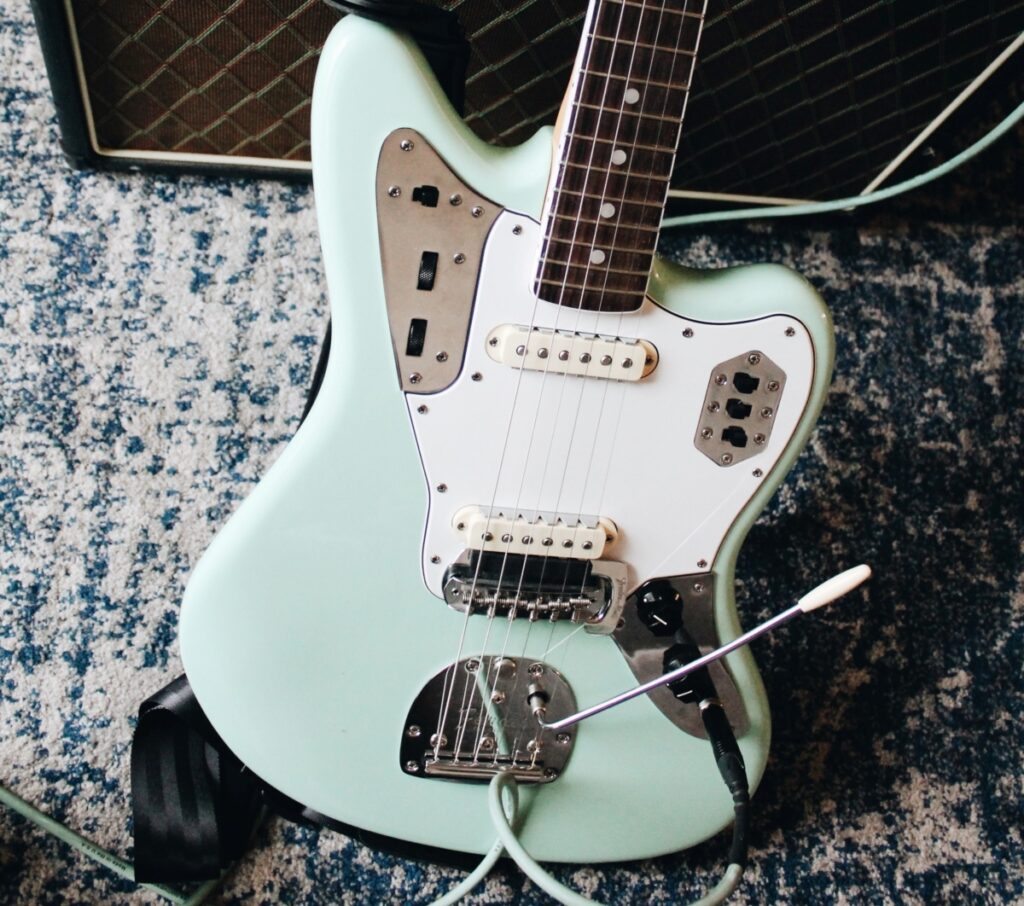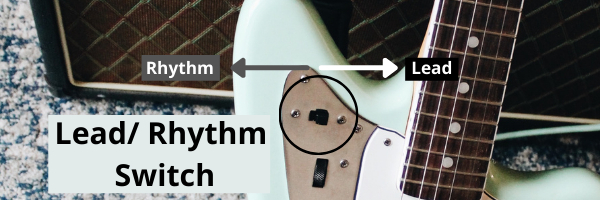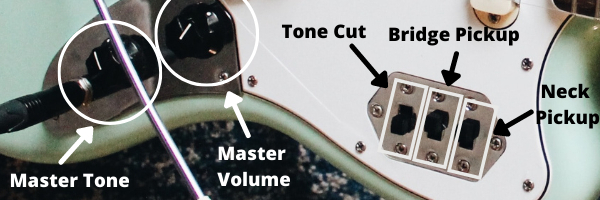The Mustang and Jaguar electric guitars are two very popular options if you’re looking for an offset body design by either Fender or Squier. In this article, I’ll compare the Mustang and Jaguar’s classic tones and designs, as well as take an in-depth look at the ranges produced by both Squier and Fender.
The Quick Answer
Mustang and Jaguar electric guitars both have 24″ scale lengths, offset double cutaway bodies, and 22 frets. The Jaguar sounds warmer compared to the Mustang which has a brighter and thinner tone. The Mustang also is lighter, has a smaller body, and fewer controls than most Squier and Fender Jaguars.
Comparing Models
Let’s look a quick look at the designs of both guitars. Here is a table comparing the Fender American Performer Mustang and Fender Vintera Jaguar, and the more affordable Squier Classic Vibe models. Keep in mind that these are just two versions of each guitar types which are similarly priced, and some features may be slightly different depending on the model in question (more on that later).
Fender Mustang and Jaguar
| Feature | Fender Jaguar | Fender Mustang |
| Body Shape | Double Cutaway | Double Cutaway |
| Body Wood | Alder | Alder |
| Pickups | Two Single-Coils | Two Single-Coils |
| Neck Shape | 60’s C | Modern-C |
| Neck Wood | Maple | Maple |
| Frets | 22 | 22 |
| Fretboard Wood | Pau Ferro | Rosewood |
| Scale Length | 24” | 24” |
| Bridge | Floating Tremolo | Dynamic Tremolo |
| Tone-Cut Switch | Yes | No |
| Rhythm/Lead Circuit | Yes | No |
| Pickup Selector | 3-way | 3-way |
| Weight | 8.5 pounds (3.9 kg) | 7 pounds (3.2 kg) |
Here are Amazon links to each version so you can check the current prices:
Squier Mustang and Jaguar
| Feature | Squier Jaguar | Squier Mustang |
| Body Shape | Double Cutaway | Double Cutaway |
| Body Wood | Poplar | Poplar |
| Pickups | Two Single-Coils | Two Single-Coils |
| Neck Shape | C-shape | C-shape |
| Neck Wood | Maple | Maple |
| Frets | 22 | 22 |
| Fretboard Wood | Indian Laurel | Indian Laurel |
| Scale Length | 24” | 24” |
| Bridge | Floating Tremolo | Dynamic Tremolo |
| Tone-Cut Switch | Yes | No |
| Rhythm/Lead Switch | Yes | No |
| Pickup Selector | 3-way | 3-way |
| Weight | 8.5 pounds (3.9 kg) | 6-pounds (2.7 kg) |
Here are Amazon links to each version so you can check the current prices:

Sound Differences
The Jaguar and Mustang electric guitar models sound fairly similar due to their single coil pickups and alder bodies. However, the Jaguar has a warmer and more mellow tone than the Mustang which sounds brighter and twangy by comparison.
The controls on each guitar are also pretty different, which impacts the kinds of tones you can achieve.
- Most Mustangs have a 3-way pickup selector, 1 tone control and 1 volume control. Some have a phase switch for each pickup as well.
- Most Jaguars have a rhythm/ lead switch. The rhythm switch activates only the neck pickup and sounds warmer. The lead switch allows you to activate either or both pickups, and sounds brighter. You can then use a single tone and volume control to make further adjustments. It also has a tone-cut switch in the lead circuit.
The way the Jaguar’s electronics are set up, makes it a pretty versatile guitar. Although slightly complicated, you can achieve a variety of tones using the different controls (more on this later in the article.
Although traditionally both guitars have single coil pickups, it’s not completely uncommon to see humbucker versions of the two models, which sound louder, warmer and darker by comparison to the traditional versions.
Here’s a video so you can listen to these two guitars being played back-to-back and hear the differences.
Look and Feel
The Mustang and Jaguar are fairly similar in terms of their appearance and feel. They both have a short 24″ scale length, offset body, 22 fret neck with a similar C-shape profile and use similar tone woods.
The main difference is that the Mustang has a smaller body so is much lighter than the Jaguar which does have a reasonably large body design. The lighter weight of the Mustang can mean its a bit more comfortable to play if you’re standing up for long periods of time.
Whilst both guitars are offset, they are not the exact same shape, as the Jaguar has a more dramatic waist in comparison to the Mustang. The tremolo is also located further back on the Jaguar than the Mustang.
Main Similarities:
- Double cutaway offset body
- Similar C-shape neck
- Maple necks and alder bodies
- 22 fret necks
- 24″ scale length
- 6 in-line headstocks
Main Differences:
- The Mustang has a smaller body than the Jaguar
- The Jaguar is around 1.5 pounds (0.7 kg) heavier than the Mustang
- Additional controls on the Jaguar
- Tremolo is located further back on the body of the Jaguar than the Mustang
I’ve written a complete buyer’s guide for electric guitars which takes you through all the things you need to consider and a step-by-step method to narrowing down your selection and choosing the best option. Here is a link to the article.
Comparing the Ranges
Before we jump into some more detail on the design differences, I wanted to take a look at the Fender and Squier ranges. I’ve made two tables to show the key features and the current Guitar Centre price (at the time of writing) of pretty much every standard model in the range.
A couple of things to note:
- The Mustang was originally designed as a “student guitar” so is usually a bit cheaper than the Jaguar.
- The Mustang is the cheapest guitar available so will likely be the most suitable for beginners.
- Only one American Mustang model is currently produced (Fender American Performer).
- More expensive Fender Jaguar models are available than Fender Mustang models.
Guitar Center are always the first place I look at when I’m interested in a new electric guitar because have a huge range of models for sale and always have some excellent deals on. Here’s a link to take you directly to Guitar Center’s electric guitar range so you can see all the offers available at the moment.
Squier Range (Under $500)
| Guitar | Origin | Body Wood | Bridge | Price | |
| Squier Bullet Mustang HH | Indonesia | Basswood | Fixed | $190 | |
| Squier Classic Vibe 70’s Jaguar | Indonesia | Poplar | 6-saddle tremolo | $480 | |
| Squier Classic Vibe Mustang | Indonesia | Poplar | Dynamic tremolo | $450 | |
| Squier Contemporary Jaguar | China | Poplar | Fixed | $480 |
Fender Range (Over $500)
| Guitar | Origin | Body Wood | Bridge | Price |
| Fender Player Mustang | Mexico | Alder | Fixed | $700 |
| Fender Player Jaguar | Mexico | Alder | Tremolo | $830 |
| Fender Vintera ‘60s Mustang | Mexico | Alder | tremolo | $1000 |
| Fender Vintera ‘60’s Jaguar | Mexico | Alder | Tremolo | $1150 |
| Fender American Performer Mustang | America | Alder | Tremolo | $1150 |
| Fender Kurt Cobain Jaguar | America | Alder | Floating Tremolo | $1400 |
| Fender American Original ‘60s Jaguar | America | Alder | Floating Tremolo | $2150 |
Specific Design Comparisons
Now let’s take a bit more of an in-depth look at the main components of each guitar, and how this impacts the tone and playability of each instrument.
Pickups
Both guitars usually have single coil pickups which sound quite bright and crisp. The main different between the two pickups, is the angling on the Mustang. The Mustang angles both pickups so the treble frequencies of the higher strings, and the bass frequencies of the lower strings are enhanced, causing the higher strings to sound bright and the lower strings to sound warmer. You can find out more about this in my article on pickup angling.
Controls
Most Mustangs have a 3-way pickup selector, allowing you to activate either the bridge pickup or neck pickup in isolation, or both together. They also have a single tone and volume control which adjusts both pickups. Some models such as the Squier Classic Vibe and Fender Vintera Mustang, also have a phase switch for each pickup. When the switches are in the same position, they are “in-phase” produces a balanced tone. When the switches are in opposite positions, they are “out of phase” the tone sounds thinner with less bass and more treble.
Jaguars have pretty different controls depending on the model. Most have a rhythm/ lead switch which activates different circuits and controls on the guitar.
- Rhythm circuit: activates only the neck pickup, and the rhythm tone and volume controls on the upper horn. This circuit sounds warm and mellow.
- Lead circuit: activates either the neck pickup, middle pickup, or both together and the master tone and volume controls. This circuit sounds brighter.
As I said, it depends on the model you’re looking at, and things can get pretty complicated. So check out my article explaining the controls on a Jaguar to learn more.


Body
Both the Mustang and Jaguar usually have alder bodies. They always have a double cutaway offset design, however the Mustang has a smaller body, making it a lighter guitar. Since there are more expensive versions of the Jaguar available, you can usually find more premium finishes on this model compared to the Mustang, which comes in pretty basic colour and finish choices.
Neck and Fretboard
Both the Mustang and Jaguar have a 22 fret neck, usually with a C-profile. The scale length is 24″ which is short in comparison to most other electric guitars, making them very comfortable to play, particularly if you have smaller arms.
Which Should You Choose?
For Beginners?
For beginners, the Squier Mustang is usually a better option than any of the Jaguar models, because it is available at a much lower price. However, both guitars are comfortable for play and will be suitable for new guitarists if budget is less of a concern.
I’ve written a complete buyer’s guide for electric guitars which takes you through all the things you need to consider and a step-by-step method to narrowing down your selection and choosing the best option. Here is a link to the article.
Here are some more articles you might find useful:


